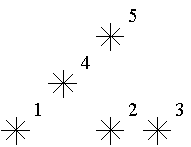Description
Astronomers often examine star maps where stars are represented by points on a plane and each star has Cartesian coordinates. Let the level of a star be an amount of the stars that are not higher and not to the right of the given star. Astronomers want to know the distribution of the levels of the stars.

For example, look at the map shown on the figure above. Level of the star number 5 is equal to 3 (it's formed by three stars with a numbers 1, 2 and 4). And the levels of the stars numbered by 2 and 4 are 1. At this map there are only one star of the level 0, two stars of the level 1, one star of the level 2, and one star of the level 3.
You are to write a program that will count the amounts of the stars of each level on a given map.

For example, look at the map shown on the figure above. Level of the star number 5 is equal to 3 (it's formed by three stars with a numbers 1, 2 and 4). And the levels of the stars numbered by 2 and 4 are 1. At this map there are only one star of the level 0, two stars of the level 1, one star of the level 2, and one star of the level 3.
You are to write a program that will count the amounts of the stars of each level on a given map.
Input
The first line of the input file contains a number of stars N (1<=N<=15000). The following N lines describe coordinates of stars (two integers X and Y per line separated by a space, 0<=X,Y<=32000). There can be only one star at one point of the plane. Stars are listed in ascending order of Y coordinate. Stars with equal Y coordinates are listed in ascending order of X coordinate.
Output
The output should contain N lines, one number per line. The first line contains amount of stars of the level 0, the second does amount of stars of the level 1 and so on, the last line contains amount of stars of the level N-1.
题目大意:
一个星星的左下角有l颗星,那么它的等级就为l。
因为星星的坐标是按照y升序给出,y相等情况下按x升序给出,则只需在每读入一个星星坐标时,统计x<=当前星坐标的星星个数即可得出当前星星等级。
所以无需处理y,只需处理x,维护关于x的树状数组。
b[i]是i-1坐标前(包括i-1)树状数组所定义的长度包含的星星坐标的个数。//树状数组感受一下
感受代码:
#include <cstdio>
#include <cstring>
const int maxn=15005,maxxy=32005;
int n;
int x,y;
int l[maxn],b[maxxy];
int lowbit(int x)
{
return x&(-x);
}
int sum(int n) //求前n项和
{
int sum=0;
while(n>0){
sum+=b[n];
n-=lowbit(n);
}
return sum;
}
void add(int x) //增加某一个元素的大小
{
while(x<=maxxy){
++b[x];
x+=lowbit(x);
}
}
int main()
{
int i;
while(scanf("%d",&n)!=EOF)
{
memset(l,0,sizeof(l));
memset(b,0,sizeof(b));
for(i=0;i<n;++i){
scanf("%d%d",&x,&y);
x++; //避免x=0的影响
l[sum(x)]++;
add(x); //放在后面因为不包括自己
}
for(i=0;i<n;i++){
printf("%d\n",l[i]);
}
}
return 0;
}